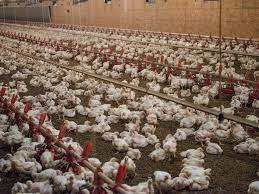 Addressing the Consumers Federation National Food Policy Conference, Attorney Sandra Eskin, Deputy Undersecretary for Food Safety at the USDA noted that the Food Safety and Inspection Service must take into consideration "the entire food production system including the farm". At this time, the FSIS does not have jurisdiction over live production, but can bring pressure on broiler producers that are non-compliant with in-plant hygiene and Salmonella standards to voluntarily require on-farm modalities to reduce the level of Salmonella entering plants.
Addressing the Consumers Federation National Food Policy Conference, Attorney Sandra Eskin, Deputy Undersecretary for Food Safety at the USDA noted that the Food Safety and Inspection Service must take into consideration "the entire food production system including the farm". At this time, the FSIS does not have jurisdiction over live production, but can bring pressure on broiler producers that are non-compliant with in-plant hygiene and Salmonella standards to voluntarily require on-farm modalities to reduce the level of Salmonella entering plants.
Eskin as a lawyer simply lumps all salmonellosis into a single bucket without taking into consideration the complex epidemiology and diverse sources of infection. She is flat wrong in her statement that "eggs and poultry are the most common sources of Salmonella." It is a matter of fact that there has not been a single case of egg-borne salmonellosis since 2010 associated with farms complying with the FDA Final Rule on Prevention of Salmonella. While it is acknowledged that a low proportion of whole carcasses and portions are contaminated with both Salmonella and Campylobacter, most well managed plants comply with FSIS standards with few cases attributed to poultry in comparison to red meat and plant products.
It is indeed unfortunate that the Administration appoints lawyers and especially those with affiliations to advocacy groups to positions that require a practical knowledge of science, epidemiology and specifically foodborne infection. Appropriate training and experience is required to develop programs to suppress diseases associated with food products. It is evident that her perceptions and approach to food production expressed by Ms. Eskin were formed in her previous position as Project Director for Food Safety at the Pew Charitable Trusts, an advocacy organization opposed to intensive livestock production At least Ms. Eskin has promised that she would listen to all stakeholders, including research scientists. A troubling reality is that Ms. Eskin appears "guided by a philosophy that government should protect people from harm that they cannot control themselves and that includes protecting people from bacteria". A whiff of “nanny-statism”
 In effect, consumers can protect themselves from bacteria that are potentially pathogenic. Has Ms. Eskin heard of hand washing, separation of raw meat and poultry from salads and uncooked foods, cooking meat and poultry to appropriate temperature and following good cooking practices whether in homes or institutions?
In effect, consumers can protect themselves from bacteria that are potentially pathogenic. Has Ms. Eskin heard of hand washing, separation of raw meat and poultry from salads and uncooked foods, cooking meat and poultry to appropriate temperature and following good cooking practices whether in homes or institutions?
Members of the National Chicken Council representing 95% of broiler production will produce a projected 44,774 million pounds of RTC in 2021 contributing to a U.S. per capita consumption of 96.0 pounds. Inexpensive poultry protein that is handled, stored and cooked appropriately should not be the vehicle of foodborne infection. The USDA-FSIS performs an efficient function in plants. The industry and consumers do not need “mission creep” onto farms especially when driven by idealistic but misguided lawyers in regulatory positions.